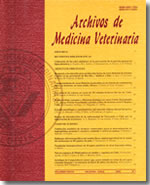Some aspects about the colonization and serologic state of Mycoplasma hyopneumoniae vaccinated sows and their piglets by parity distribution
Main Article Content
Abstract
The aim of this study was to determine the colonization and serologic state of piglets and sows of different ordinal number of farrowings. Between 78 and 81 sows, multiple-vaccinated against Mycoplasma hyopneumoniae (Mh), were sampled (from 1st to 9th parity) at day 0 of gestation, 8 weeks of pre-farrowing and post-farrowing, and 163 piglets at two weeks old, taking blood samples (for enzime-linked immunosorbent assay test, ELISA) and nasal swabs (for polymerase chain reaction, PCR). In addition to the percentages of seropositive and PCR positive, other values were obtained to determine the concentration of antibodies and to analyze the dynamics of antibodies in sows and piglets. The percentage of seropositive sows and title values were both high. The same was observed in piglets, allowing to conclude that the multiple vaccinations of the first ones guarantees a high level of antibodies in their offspring, but not 100%. The sows of intermediate parity number showed a higher variability in those values that reflected concentration of antibodies; at day zero of gestation the sows of first farrowing showed these lower values. At post-farrowing, younger sows and their offspring showed the highest percentage of nPCR positive. Sows (and piglets) showed a higher concentration of antibodies when increasing the number of ordinal farrows, although this can be due to vaccination and the repeated exposure of the animals to Mh under field conditions.

